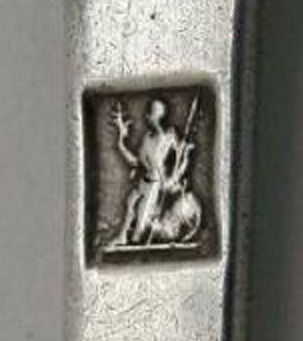Britannia silver
What is Britannia silver?
Britannia silver, also known as 958 silver was introduced in Great Britain in 1697 as a compulsory higher purity standard for silver plate. Prior to this time, both silver plate and silver coins were made at 925 or "sterling" silver purity.
Britannia silver objects were stamped with a "Lion's head erased" and a figure of Britannia instead of the previous Lion Passant Guardant that denoted Sterling silver. The Britannia figure is sometimes seen in an oval stamp and sometimes in a rectangular. Since January 1st, 1999, the old Britannia symbol has become optional as a hallmark for Britannia silver - and the 958 "millesimal fineness" mark has become the standard mark. Britannia silver is much less common than sterling silver.

Britannia silver mark
Increasing the purity of silver plate was one of several legal measures introduced as part of the Great recoinage of 1696, which attempted to limit the illegal practices of coin clipping and coin melting. Coins continued to be issued at 925 purity - and the objective of the higher standard for silver plate was that shavings obtained from sterling silver coins would no longer be of sufficient purity to melt down and use for silver plate, and plate made in this fashion would fail an assay test. [1]
Although known as "958", Britannia silver is actually at least 95.833% pure silver, being equivalent to 23 carat or 23/24 pure. The remaining 1/24 of the alloy is typically copper. In old times, Britannia silver was made using 11 (troy) ounces and 10 pennyweights (dwt) of silver to 10 dwt of alloy. There are twelve troy ounces in a troy pound and 20 pennyweights to the troy ounce. (see homepage article: What Is A Troy Ounce?)
Being of higher purity than sterling silver, the Britannia silver introduced in 1697 was a softer alloy. Some British silversmiths were opposed to its use however the French standard was 95% ("Minerva" silver), so all of a sudden English silver was able to be exported to France.
In the end, the strategy did not prevent coin from being melted down, and so in 1720, sterling silver was readmitted for use by silversmiths and Britannia remained as an optional silver standard. A duty was introduced for wrought silver goods, which meant that it was not profitable to melt the coin. [2] Sterling silver returned to being the principal standard used for silver household objects, status symbols which reached the height of their popularity in the Victorian era. In Victorian times, a very large number of household objects - from perfume bottles and cigarette cases to mirror frames and of course cutlery - were made from 925 sterling silver. Sterling silver continues to be one of the most common standards used by silversmiths for silver jewelry, flatware and other silver objects - however Britannia silver has remained as an optional silver standard.
Other millesimal fineness numbers sometimes seen include 925 ("Sterling silver"), 999 ("Fine silver" or "Three Nines Fine"), 950 ("French First Standard"), 900 (USA coin silver), 833, 995 and several others. Gold is often seen stamped at 916, also known as crown gold, which is equivalent to 22 carat, 585 (14 carat) or 375 (9 carat). Platinum jewelry is most often seen at 950 purity.
Calculating The Amount Of Silver In Britannia Silver Items
To calculate the amount of actual silver in a Britannia silver item, first weigh the item and then multiply the weight by 0.95833.
Silver Britannias
Britannia silver should not be confused with silver britannias, which are a type of bullion coin. These coins are silver bullion coins which have been issued in the UK by the Royal Mint since 1997 (gold britannias have been issued since 1987) and have a reverse design depicting Britannia, standing. [3]
Britannia Metal
Another possible cause of confusion for the unwary - britannia metal is not the same as britannia silver. Britannia metal, also known as britannium, britannia ware, or by an old trade name "Vickers White Metal", is a type of pewter (tin alloy) and contains no silver at all - being 93% tin, 5% antimony and 2% copper. Britannia metal was at one time widely used as a base metal for silver plated items and these may be marked with the letters EPBM, short for electro plated Britannia metal. [4]
Britannia silver - Info Sources
[1] http://en.wikipedia.org/wiki/Britannia_silver
[2] http://www.ascasonline.org/articoloAGOSTO86.html
[3] http://en.wikipedia.org/wiki/Britannia_(coin)
[4] http://en.wikipedia.org/wiki/Britannia_metal

Privacy Policy |
Cookie Policy |
GDPR

Disclaimer - While every care was taken in the preparation of this website (www.troy-ounce.com) and its contents, no guarantee is made as to the suitability of this website for any purpose whatsoever, nor of the accuracy, timeliness or usefulness of its information. This website is provided for general information and entertainment purposes only and the information provided on this web site should not be seen as, nor as a substitute for, legal, business or investment advice. The website's owner specifically disclaims any and all liability arising in conjunction with the use of the materials / information herein.
